What Exactly Is Self-Service Analytics?
The best self-service analytics tools, pricing, pros, cons, and best practices in implementing them.
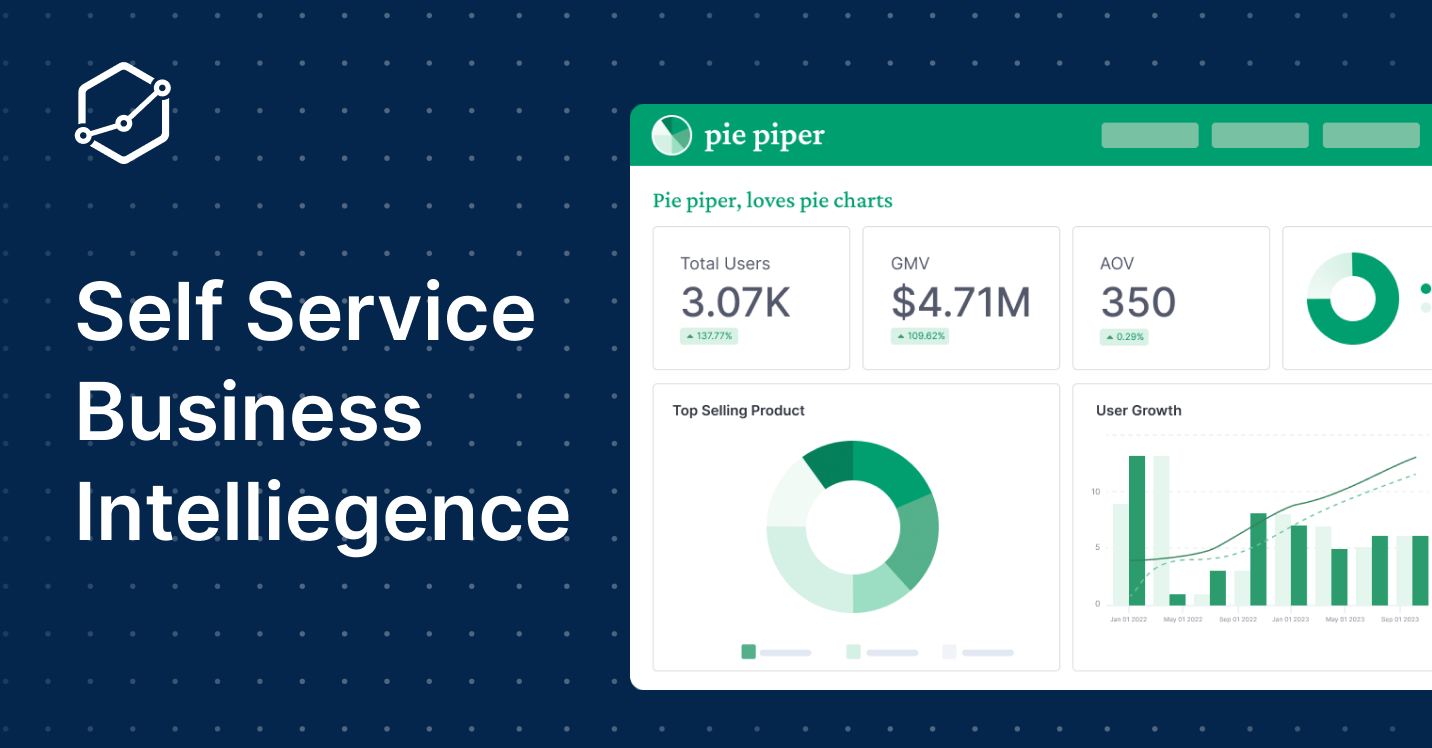
A Holistics colleague of mine, Dave, has this thing where he says 'No data tool can ever help you achieve data literacy in your company. But we sure can make sure we don't get in the way.'
I think about that a lot.
As a tool maker, it's easy to introspect too much and think about all the ways Holistics can solve all of our customers's problems, and make their lives better, and make them write happy emails to us, and so on. But the truth is that business intelligence problems are socio-technical problems, and you usually have to fix some combination of people (read: culture) and process and tool, all at the same time.
Which brings us to today's topic.
What Exactly is Self-Service Analytics?
It shouldn't be a surprise to anyone that self-service in the business intelligence space is hard to define. Benn Stancil (Mode Founder) has a whole piece where he argues 'self service is a feeling' — which I largely agree with — and Stancil says that what self-service analytics is depends on how the org feels about self-serving data from their tools.
Do they trust it? Do they feel comfortable getting what they need, without emailing an analyst?
This, Stancil continues, depends on the context of the organization (do they trust the numbers in their data systems?), their data maturity (do they feel comfortable with their BI tool?), the needs of business users (does the CEO set the tone for metrics consumption?)
So, yes, the organizational context matters when you're talking about self-service analytics. A self-service setup that works in one company might not be equivalent self-service in another.
But I think we can get more specific than 'Self-service is a feeling'.
Instead, I'm going to invert the question and define self-service analytics by what it's not. Because I think this is more useful.
In a sentence, I think self-service can be thought of as a business outcome that successfully avoids a common organizational failed state. To put this more concretely, I think self-service analytics is a state where the business is sufficiently data-driven, but the data org does not look like an army of English-to-SQL translators.
,
You are a small company.
You realize you need a data analytics team, so you hire your first analyst and you use Google Data Studio or Tableau, or some other BI tools. Your analyst churns out reports for management, and all is well for a few months. But eventually your analyst can't keep up with all the requests she's getting from end users, so you hire another. And another. And another. And then your company grows up, creates departments that report to different leaders, and each department hires their own analysts, and now you have an army of analysts in various parts of the company all writing queries or tuning Excel spreadsheets, just trying to keep up with the business requests your company throws at them.
These analysts are mostly English-to-SQL translators or Excel jockeys. They're all relatively junior. Some are senior, sure. But there's not much career progression for them overall. And many of them are suitably displeased with their jobs, and a reliable percentage of them churn out (read: quits your company) every six months or so. You keep hiring new analysts to keep up with business demand and grit your teeth at the management challenge of constantly churning employees.
This is the failed state.
(Note that in this scenario, your company is data-driven. This isn't always a thing! It's more common to be in a company that isn't data-driven, which doesn't have this problem, and will instead have a different set of problems and a different set of failed states. Anyway.)
This is the failed state that self-service analytics is supposed to solve. It is a failed state because it's rather painful to maintain an army of English-to-SQL translators. Ideally, you want a smaller group of data folks that can service a much larger number of data consumers. And the only way you can hit that scale is to have some form of 'self-service', that is, some way that business users can get the data they need, without going through an analyst on Slack or email.
In other words, self-service business intelligence is valuable as a goal because it increases the operating leverage of your data team. You can serve many more people with fewer analysts. This is an ideal business outcome.
Now: notice that I have not defined what features a self-service analytics platform should have in this context. Notice that I have not talked about tools, or processes, or even org structure. All of these depend on the nature of the company.
Instead, I'm describing self-service analytics by telling you what it is not — it is not this failed state where the company is data-driven, but they've gotten there by just throwing bodies at the problem, and have 100 data analysts spread across six departments writing 100-line SQL queries. Self-service, when seen through the lens of my inverted definition, is how far away you are from that failed state.
Of course, smart readers would recognize that this is simply another way of saying 'In a data-driven company with high demand for data, bad data organizations tend to self-service look the same, but working data organizations look very different from each other'. And indeed, data-driven companies with good self service capabilities all look very different. For instance, in one consumer software company I know, many people in the company's reporting structure are fluent with SQL, so they are able to solve their self-service problems with a combination of a SQL-oriented BI tool, a well-curated data warehouse, and one or two visualization tools. This would not work in a cosmetics company where the majority of their staff aren't SQL-savvy and prefer to have dashboards built for them. Self-service in the first company looks different from self-service in the second.
In other words, self-service business intelligence is most usefully described as a business outcome — a place that you get to through a combination of tools and processes, and org structure. And the way you get to it is by asking yourself, each step of the way: "Does this move bring us closer or further away from the failed state?"
In such a scenario, the best thing a tool can do is to not get in your way. The best thing a Business Intelligence tool can do is to give you handles when you want to evolve your org away from the failed state.
Finding a self-service BI tool is the easier part. The truth is that business intelligence problems are socio-technical problems, and you usually have to fix some combination of people (read: culture) and process and tool, all at the same time.
But one problem at a time.
In this article, we’ll go into what makes a good self-service BI tool, analyze the best tools in the market, and go into a few success case studies to help get a better picture of what success looks like, and how to achieve it with a combination of People, Process, and Tool.
How To Evaluate Self-Service Analytics & BI Tools
Over the years, we've received hundreds of RFPs (Requests for Proposal) from a wide range of companies, from Fortune 500 giants to Series A startups. We've compiled all their evaluation criteria into this template. Feel free to clone and customize it to suit your needs.
Not all self-service analytics tools are created equal.
Some promise the world but deliver a steep learning curve; others are so user-friendly that you wonder if they’re too simplistic. To truly empower users while maintaining data integrity, a self-service analytics tool needs to strike a delicate balance between functionality and ease of use.
Here’s a closer look at the key features that make a BI tool self-service-able:
- User-friendly interface & Ease of Use: The best self-service analytics tools are designed with the non-technical user in mind. A drag-and-drop interface, intuitive dashboards, and simple data visualization options are essential. These features lower the barrier to entry, allowing users with little to no technical background to explore data and generate insights.
- Customizable dashboards: Every business user has different needs, and a one-size-fits-all dashboard simply won’t cut it. The ability to explore and customize dashboards allows users to focus on the metrics that matter most to them.
- Collaboration features: Insights are only valuable when shared. Collaboration features—the ability to easily share dashboards to Slack and emails, send alerts, share password-protected shareable links, or create embedded analytics dashboards —are essential. This helps cross-department teams work together, align on strategies, and make informed decisions based on the same set of data.
- Single source of truth and centralized logic: One of the biggest challenges in data-driven decision-making is making sure that everyone in the organization is working with the same definitions and metrics. A self-service analytics tool should allow you to centralize data logic and metrics ensuring that reports generated across different departments are accurate and consistent.
- Variety of visualization options: A robust self-service analytics tool should offer a wide range of visualization options, from basic charts and graphs to more complex visualizations like heat maps, scatter plots, and geographical maps.
- Data Governance and Granular Role Permissions: Sensitive data should be tightly protected and users only have access to the data they need. This helps maintain compliance with data protection regulations and ensures that the right people are making the right decisions with the right data.
- Version Control: When more people build metrics and dashboards, the BI reporting system can become this big chunk of spaghetti logic that nobody dares to touch. Dashboards break out of nowhere. Your self-service BI should allow you to define analytics and dashboard as code and govern them with Git version control.
- Usage Monitoring: A lesser-known but equally important feature of self-service BI tools is usage monitoring. This capability allows the data team to identify under-used dashboards, prune redundant reports, discover data champions, support struggling data novices, and share best practices, improving the overall data proficiency across the entire organization.
10 Best Self-Service Analytics Tools and Platforms
In this section, we'll explore the top self-service analytics tools: Holistics, Looker, Metabase, Tableau, Power BI, Thoughtspot, and Sigma.
The first two, Holistics and Looker, are code-based, semantic-modeling self-service analytics tools. They're ideal for data teams who want everyone in the organization to explore data using curated, governed datasets.
The next three, Metabase, Tableau, and Power BI, are visualization-centric, SQL-based tools. They're best suited for businesses heavily invested in board reporting, where the demand for self-service exploration primarily comes from select power users and teams prioritizing polished reports and presentations.
The last two, Thoughtspot and Sigma, focus heavily on search-driven and spreadsheet-like analytics experiences. They cater to business users looking for an even simpler self-service experience.
1. Holistics
Holistics is a self-service analytics platform that strongly focuses on data governance and centralization to keep metrics consistent across teams.
It offers a wide variety of features designed for self-service analytics, governance, and customization.
Holistics Demo
Key features:
- Semantic modeling: With a code-based semantic layer approach, Holistics allows the data team to define data logic and metrics centrally, ensuring all teams use the same well-defined metrics and dimensions.
- Easy data exploration: Non-technical users can easily filter, sort, and drill down into data within an intuitive drag-and-drop interface. Common analytics functions like Percent of Total or Period-over-Period comparison are all 1-click functions, natively built-in.
- Robust variety of visualizations: Offers a wide range of visualization options, from basic charts to more advanced geographical maps.
- Dashboards as code: Allows users to build dashboards by arranging analytical blocks such as text, charts, and filters on a customizable canvas. Because everything is defined as code, users can also govern dashboards with Git version control and turn these analytics blocks into reusable components for future use.
- Embedded analytics and external analytics: Users can easily send reports to Slack and email, share data securely with password-protected shareable links, and embed dashboards into their own documents/applications.
- AI-assisted Exploration: Provides a natural-language interface to query data and create visualizations. AI-generated metrics can be stored, reused, and further extended by users.
The Cons
- No predictive analytics feature: At the moment, Holistics does not support predictive modeling. For instance, you can’t deploy machine learning models to forecast propensity to buy based on your data in Holistics.
- User experience (UX): Holistics might seem rough around the edges for some users as the interface can feel less intuitive compared to other BI tools.
Pricing: Starts at $800/month

2. Metabase
Metabase is an open-source business intelligence tool that helps users answer their data questions using different visualizations.
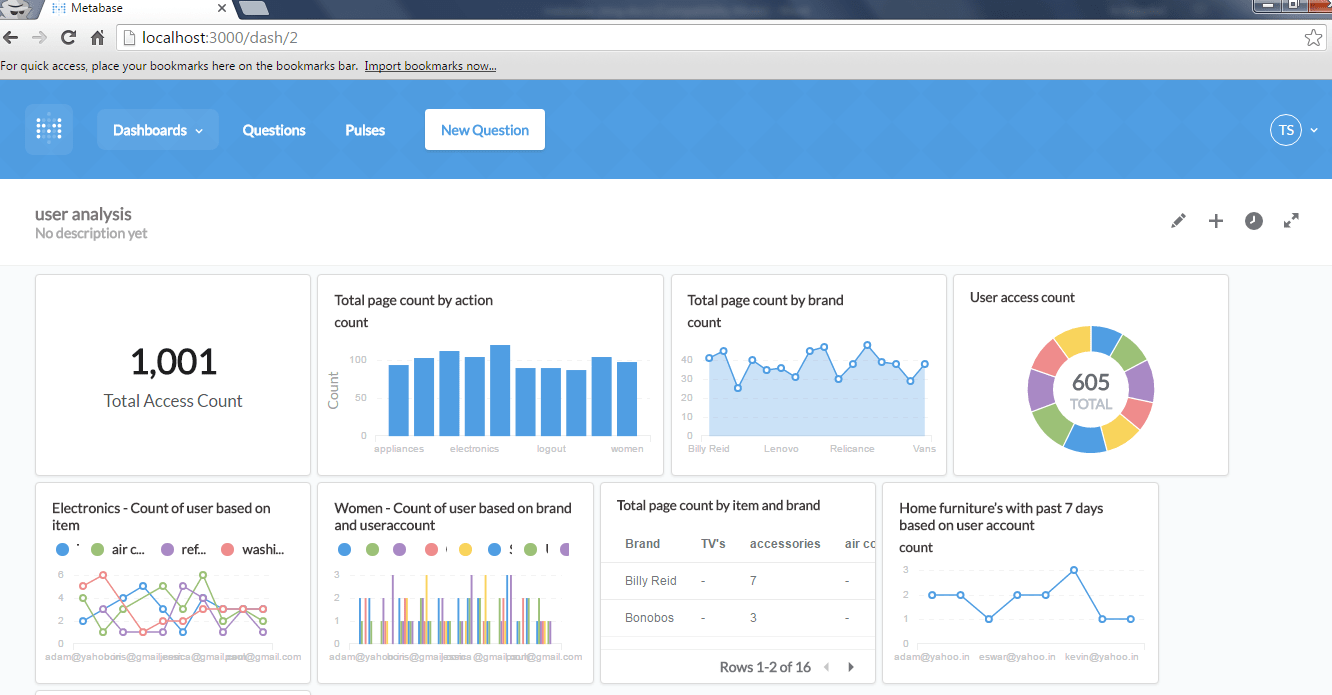
Key Features
- Ease of use: Metabase’s point-and-click interface is designed for non-technical users, making data exploration straightforward without needing SQL.
- Simple query builder: For those with SQL skills, Metabase offers a simple query builder, allowing for deeper data analysis and custom queries.
- Open-source flexibility: As an open-source tool, Metabase offers significant flexibility for customization and integration, tailored to your organization’s specific needs.
- Basic visualizations: Metabase covers the essentials with bar charts, line graphs, and more—sufficient for most business needs.
- Question feature: Metabase has this question feature that lets you answer your simple and daily data questions. In “Simple question” mode, you can filter, summarize, and visualize data. If you have a more complex question, you may choose “Custom questions” which gives you a powerful notebook-style editor to create more complex questions that require joins, multiple stages of filtering and aggregating, or custom columns.
The Cons
- Heavily dependent on MySQL for complex analysis: If your query is too complex for the question feature, you need to write your own MySQL script to get your desired results. This is not user-friendly for people with limited SQL knowledge.
- Performance at scale: It works well for smaller datasets but can struggle with performance when scaling up, particularly with complex queries.
- Security and governance: Being open-source, Metabase may require additional setup for enterprise-level security and governance, which could be a hurdle for some organizations.
- Lack of automated data mapping: Unlike its competitors that automatically do the data mapping between database tables and business logic once the data source is integrated, You need to do your data mapping manually in Metabase and this leads to less flexibility and lack of customization.
Pricing: Starts at $85/month, with $5/month per user
3. Looker
Looker is an enterprise cloud-based self-service BI tool owned by Google that sits on top of your SQL database and helps you model and visualize your data.
Key Features
- Strong data modelling capabilities: Looker has its own data modeling language called LookML. With LookML you can define your dimension, metrics, calculations, and data relationships in A SQL database.
- Predictive analytics: Looker offers various data tools that can help you get the most out of your analysis including ML models that can be deployed in your dataset. For instance, There are BigQuery ML models available within the Looker Marketplace including classification, regression and time series forecasting models.
- Flexible data exploration: Users can create custom reports and dashboards with a drag-and-drop interface, and drill down into data for detailed insights.
- Robust data integration: Looker connects directly to a wide range of databases and cloud warehouses, ensuring real-time data access without the need for extraction. It integrates well with tools like Slack and Google Sheets and other Google Products, making collaboration easier.
Limitations:
- Complexity of LookML: LookML is powerful but has a steep learning curve, requiring technical expertise which may increase reliance on data engineers.
- High Cost: Positioned as a premium product, Looker’s pricing may be a barrier for smaller organizations. Looker pricing is reported to start at $35K/year.
Pricing: Starting at $35K/year.
4. Thoughtspot
ThoughtSpot is well-known for its focus on AI-powered, search-driven analytics, making data exploration easy even for non-technical users. Here’s why it stands out as a self-service analytics platform
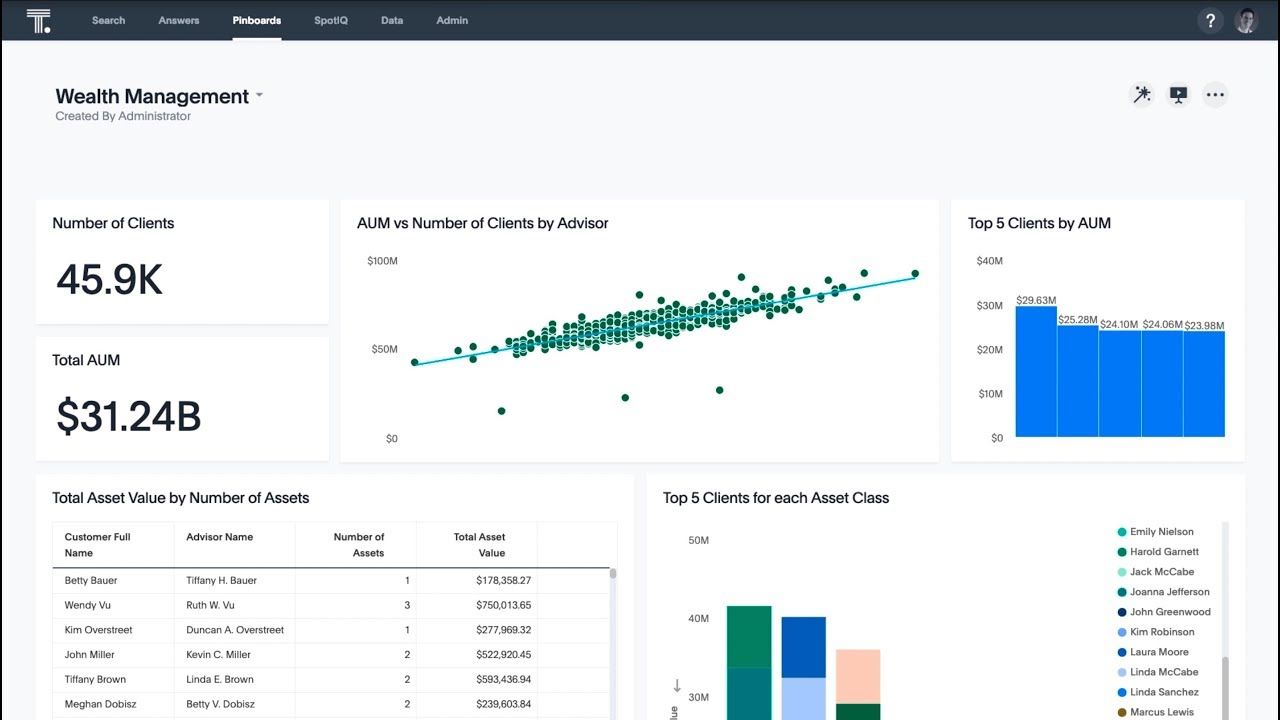
Key features:
- Search-driven analytics: Type in a question in plain English, and ThoughtSpot delivers instant insights. This makes it super accessible, even for those without a tech background.
- AI-powered insights: The platform uses AI to automatically highlight trends, anomalies, and hidden opportunities you might not have noticed.
- In-memory computing: This feature speeds up query processing, making it great for organizations that need fast decision-making.
Limitations:
- Complex setup and maintenance: ThoughtSpot is easy for users but can be tricky to set up and maintain, especially in larger, complex environments.
- High cost: It’s a premium product with pricing to match, which might be a barrier for smaller businesses.
- Limited advanced customization: ThoughtSpot may not offer the deep customization options for reports and dashboards that other BI tools do.
Pricing: Starts at $1250/month
5. Tableau
Tableau is a powerhouse in BI, known for its stellar data visualization and user-friendly design.
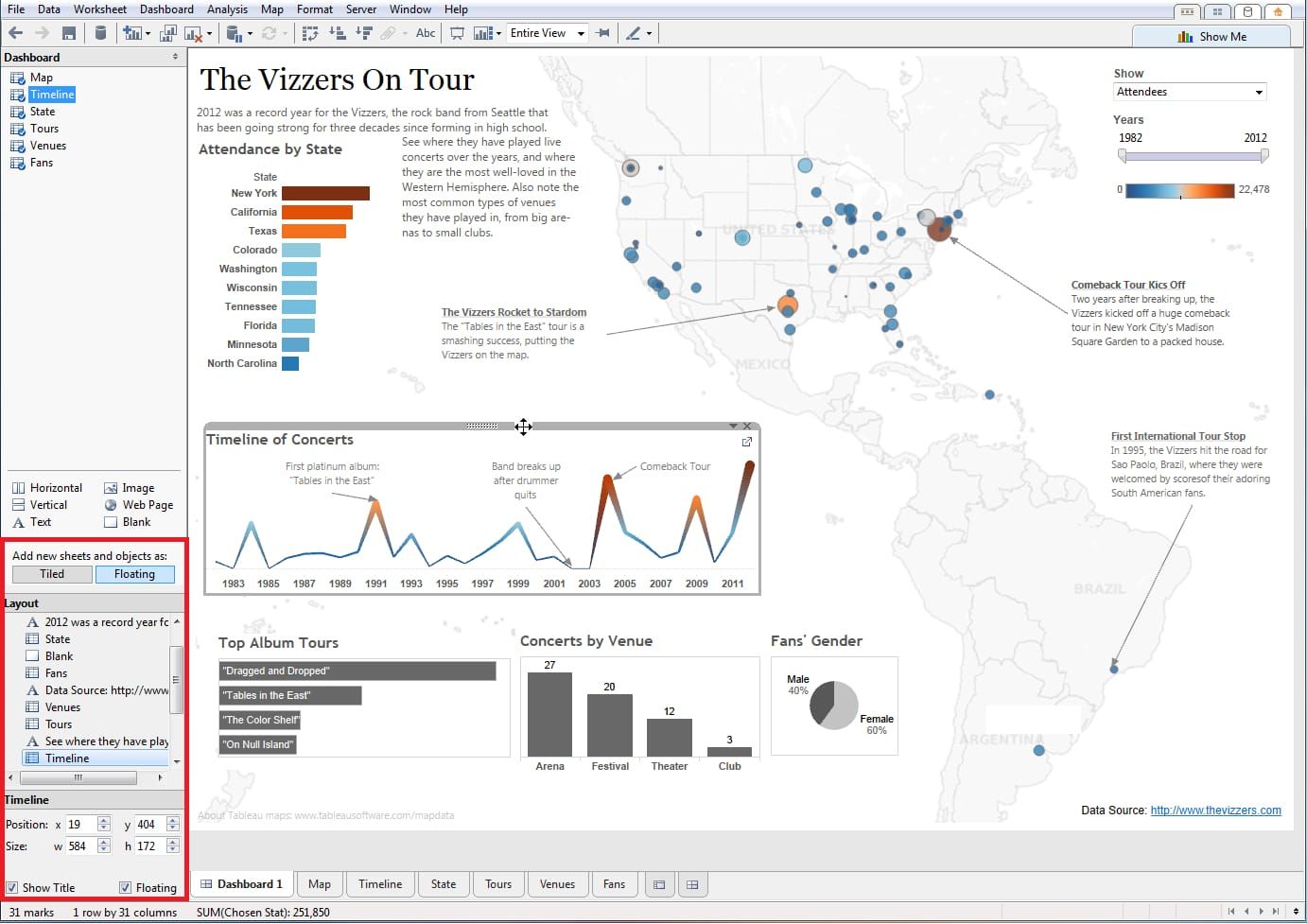
Key Features
- Excellent data visualization: Tableau excels at creating a wide range of visualizations, from simple charts to complex interactive dashboards, all through an easy drag-and-drop interface.
- Real-Time Analytics: Tableau supports live data connections, ensuring your insights are always up-to-date, which is critical for agile decision-making.
- Collaboration features: Share your insights easily with Tableau Server or Tableau Online, fostering a data-driven culture across teams.
The Cons
- High learning curve for non-technical users: Unlike other BI tools such as Holistics or Looker that allow non-technical users to explore data and generate insights, the majority of Tableau users are experienced analysts or developers as setting up data models and generating insights sometimes need programming knowledge such as SQL, R, and Python. Business users can self-serve with Tableau, but it often involves a lot more training.
- Lacking built-in self-service BI features: Tableau may not have built-in support for certain features that are needed for self-service exploration, such as fiscal calendars or relative date range defaults on the date slider.
- Difficult to embed into organization’s products: You can embed Tableau into external applications such as internal knowledge bases, CRMs, and blog posts. However, seamlessly integrating Tableau can be a real challenge for an organization from both financial and technical perspectives.
06. Lightdash
Lightdash is a fresh player in the BI scene, built specifically for teams using dbt (data build tool) for data transformations.
It’s a developer-friendly platform that turns your existing dbt models into customizable dashboards and reports. Here’s what makes Lightdash tick as a self-service BI:
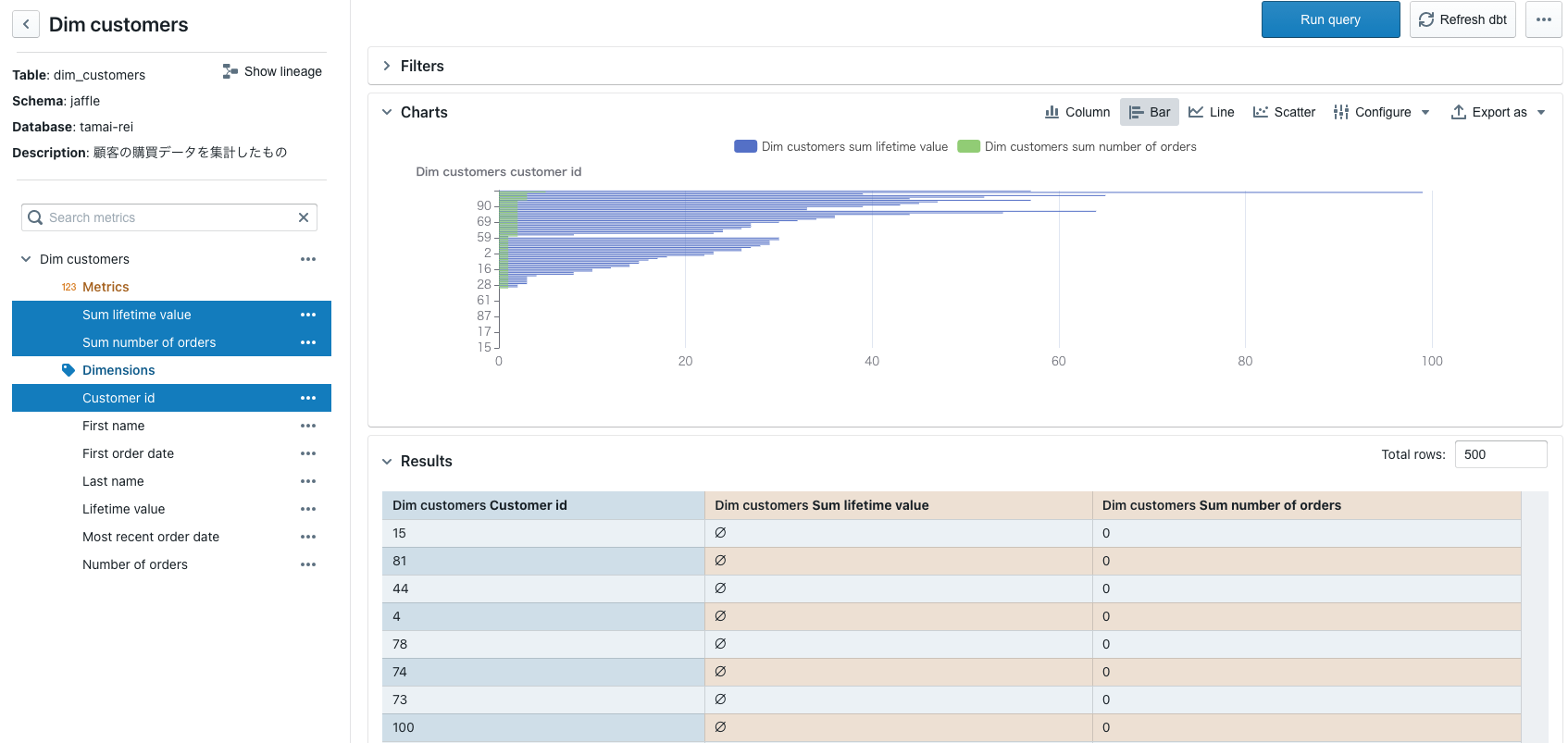
Key Features:
- Seamless dbt integration: Built with dbt users in mind, Lightdash integrates directly with your dbt models, avoiding duplicate efforts and keeping your data consistent.
- Developer-centric: Ideal for teams comfortable with SQL and coding, Lightdash lets developers craft and tweak dashboards straight from dbt models.
- Open-Source Flexibility: As an open-source tool, Lightdash gives you plenty of room to customize, integrate, and even contribute to its development.
The Cons
- Product immaturity: Since Lightdash is new to the market and still in early development, its visualization options are quite limited in comparison to other BI tools.
- Steep learning curve: Geared towards technical users, non-developers may struggle without extra training.
- Performance Issues: Still evolving, Lightdash may face performance hiccups with large datasets or complex visualizations.
Learn more: How Lightdash Could Be Better
07. Sigma Computing
Sigma Computing is designed to make cloud data warehouses accessible to everyone, offering a spreadsheet-like interface that’s intuitive for users without SQL skills.

Key Features:
- Spreadsheet-Like Interface: Feels familiar to Excel users, making it easy to create reports and analyze data without needing to learn SQL.
- Collaboration and Governance: Multiple users can work on the same datasets, with robust data governance features to keep everything secure and compliant.
- Scalability: Built to grow with your data, Sigma handles increasing data volumes and complexity without a hitch.
Limitations:
- Premium Pricing: Sigma is a premium product, which might be pricey for smaller businesses or those on a budget.
- Customization Limits: May not offer as much customization for specialized reports or niche visualizations as other tools.
Pricing:
- Sigma operates on a subscription model, with pricing scaling based on users and features. It’s generally on the higher end, suited for mid-sized to large enterprises.
Self-Service Analytics Best Practice: A Case Study
In the classic 1989 movie Field of Dreams, Kevin Costner’s character, Ray, hears a voice whispering, "If you build it, they will come."
So despite taunts of lunacy, he builds a baseball diamond in his cornfield, and sure enough, the ghosts of legendary players show up to play ball. The phrase became iconic, suggesting that if you create something valuable, people will naturally gravitate toward it.

But when it comes to self-service analytics, it’s not that simple.
You can’t just buy a self-service BI tool and expect everyone to start using it right away. You need training, education, and a cultural shift to get people to embrace data thinking.
The data teams at Spenmo (Fintech, $500M valuation) and ZOE (Nutritional Science, $250M valuation) show how focusing on people and processes can lead to successful self-service BI adoption.
Here’s how they did it.
1. Understanding Different Data Needs (People)
Success starts with empathy.
Spenmo’s data team knew that different departments needed different things. The strategy team needed ad-hoc analysis, which required more self-service enablement, while the operations team required consistent dashboards. Instead of a one-size-fits-all approach, they tailored their solutions:
- Operations: Created evergreen dashboards that required minimal updates, allowing the team to monitor key metrics without constant data team involvement.
- Strategy: Educated the team on how to ask the right questions and use Holistics to find their own answers, empowering them to conduct independent, data-driven analysis.
Spenmo’s data team puts their users first and constantly asks themselves: “how can I help them succeed?”.
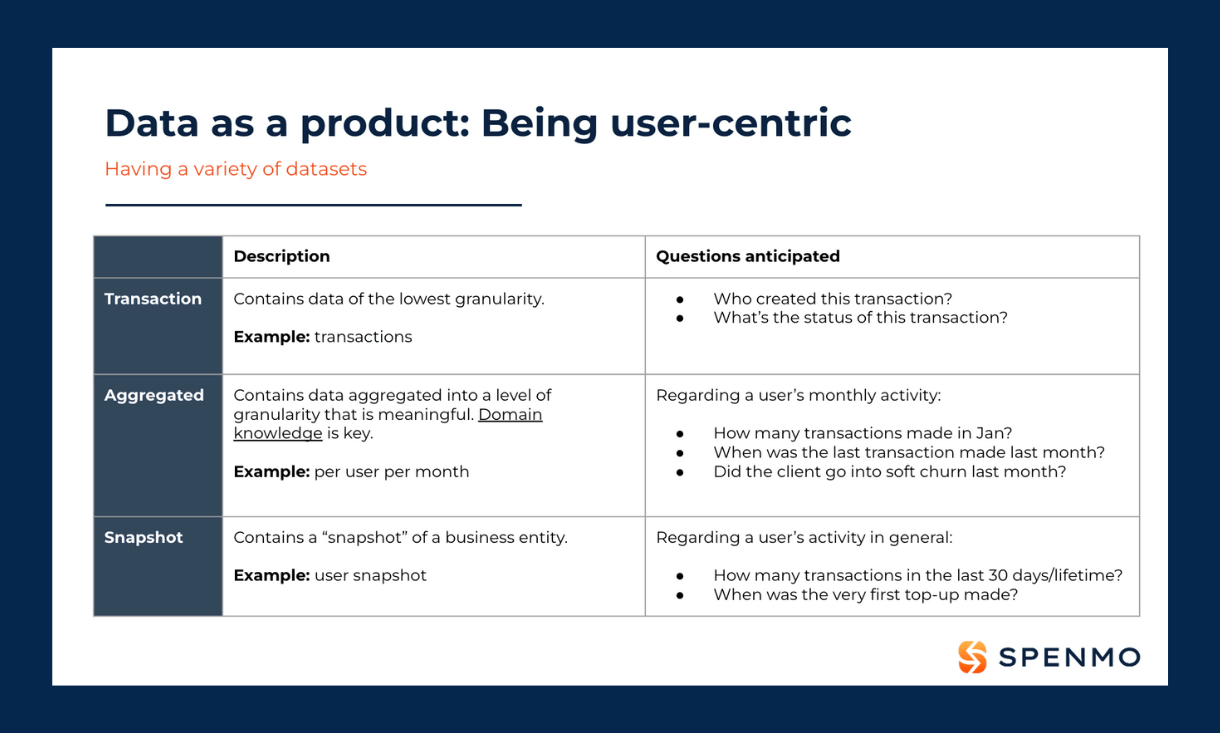
The answer to this question is the variety of thoughtfully designed datasets that can cater to different analytical needs and maximize the number of use cases to be served by each data table.
2. Education: Implementing Data Clinics (People)
Spenmo introduced data clinics—open sessions where users could learn, ask questions, and get guidance on using BI tools. These clinics helped build a culture of self-sufficiency while protecting the data team’s time from being consumed by “quick questions.”
The success of data clinics is well-documented.
For example, in a presentation shared with the dbt Slack community, Jacob from Montreal Analytics reported that the number of self-serve business users on their BI tool increased tenfold after implementing data clinics. This kind of structured support helps bridge the gap between data teams and business users, moving the organization closer to full-fledged self-service capabilities.
We wrote a detailed guide on how to set up data clinic and promote self-service culture here. Check it out!
3. Setting Clear Expectations (Process)
Processes matter. At Spenmo, the data team was upfront about their limitations.
When users requested data, they were told it could take up to eight weeks. But they didn’t leave them hanging—instead, they offered to train users to find answers themselves using their self-service BI tool, often with just a one-hour session.
This approach not only encouraged self-sufficiency but also made users feel supported and confident in their data skills.
4. Creating Comprehensive Documentation (Process)
Thorough documentation was another cornerstone of Spenmo’s success. The data team developed detailed documentation for every data table in Holistics.
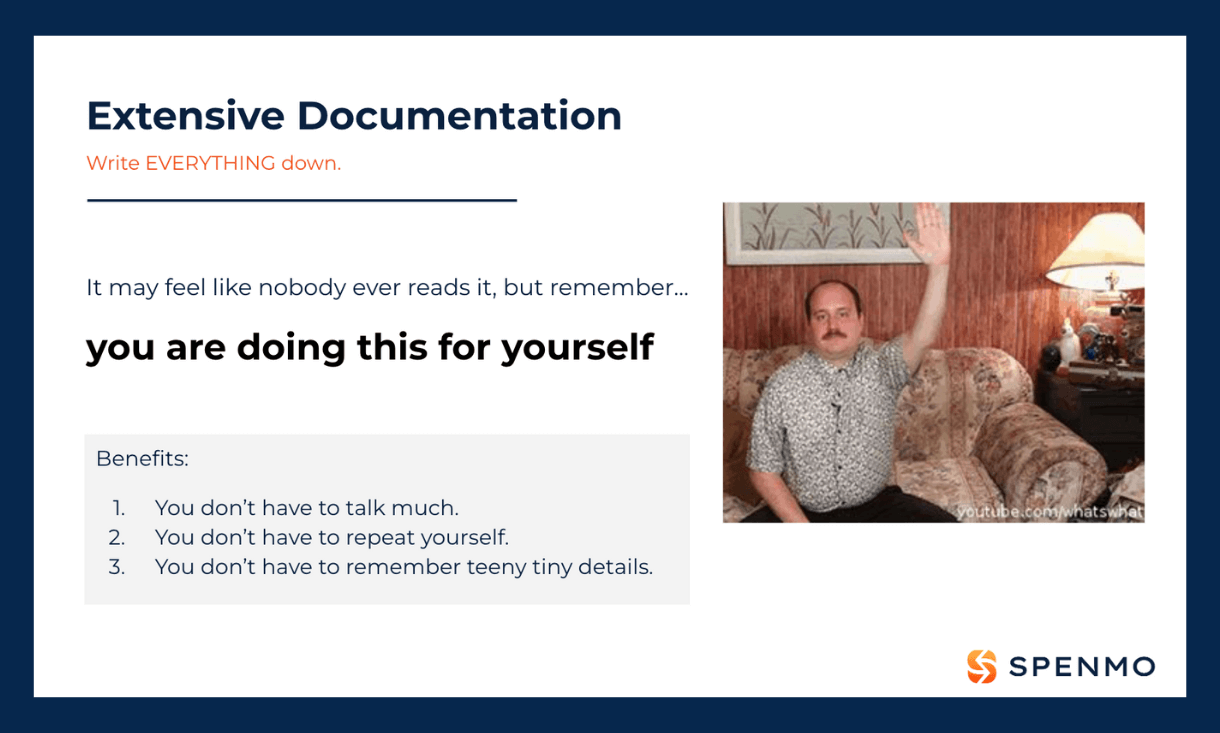
This documentation ensured that business users were fully aware of:
- Which data was available for exploration?
- Which datasets were most appropriate for their specific analyses?
- What data to expect in each column?
- The source tables were used to populate the data, which was crucial for validation purposes.
By making this information readily available, the data team enabled business users to navigate the data landscape more confidently and independently. Comprehensive documentation is a cornerstone of effective self-service, reducing the need for constant guidance and helping users make the most of the BI tools at their disposal.
Solving the Self-Service Analytics Problem Today
If you’ve read our Analytics Setup Guidebook, you can probably guess at what we think about this: unlike ‘second wave’ BI tools, we think that:
- Data modeling at a central data warehouse is part of the solution space: Define your business definitions once, in a modeling layer, and then parcel these models out for self-service. In this way, you get all the benefits of self-service analytics without the problems of ill-defined, inconsistent metric definitions
- Another part of the solution space is analytics as-code. We believe that you should apply software engineering best practices to business intelligence: Define your analytics and reporting logic as code, put them through a Git-based review process, make sure the automated tests pass, then deploy to production. That way, you know exactly when, where and who made changes to your dashboard. Your analytics output is tightly controlled, and business user can consume the data with great confidence.
As far as we can tell, the only self-service BI tools to adopt this approach is Looker and Holistics. We expect more tools to adapt accordingly, however, especially if these ideas prove their worth in practice.
Will this approach win out in the end?
We’d like to think so. We think that there are many advantages to this approach. However, we can not know what problems will fall out of this new paradigm. We will have to wait a couple of years to see.
What's happening in the BI world?
Join 30k+ people to get insights from BI practitioners around the globe. In your inbox. Every week. Learn more
No spam, ever. We respect your email privacy. Unsubscribe anytime.

